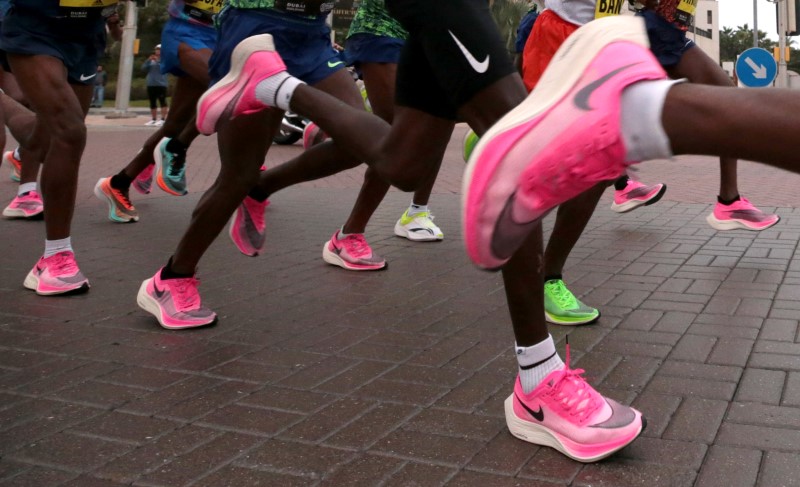By Mitch Phillips and Kate Kelland
LONDON (Reuters) - Athletics' ruling body will tighten regulations governing shoe technology, two sources familiar with the matter said, after Nike's popular Vaporfly brand helped re-write running records and sparked debate about whether it was "technological doping."
World Athletics expects to announce the findings of a review into technology used in road and track shoes by the end of January.
Recreational runners' use of the fluorescent footwear will be unaffected, World Athletics said. Vaporfly combines carbon plate and ultra-springy compressed foam and is now a familiar sight at starting lines across the world.
"World Athletics definitely agrees that there needs to be greater clarity on what is permissible in elite sport and in our competitions," it said in a statement to Reuters, adding that any change would need to be ratified by its council.
"It is not our job to determine the shoe running market for everybody. If people want to run a marathon in Vaporflys or any other shoe, it's not our job to stop them. But if you want a ratified record, then you are classified as elite and have to abide by the rules."
When asked about the review and a possible change of rules, Nike (NYSE:NKE) said: "We respect the IAAF (now World Athletics) and the spirit of their rules, and we do not create any running shoes that return more energy than the runner expends."
Regulations state that any shoe "must be reasonably available to all in the spirit of the universality of athletics and must not be constructed so as to give athletes any unfair assistance or advantage."
The governing body, which has longstanding restrictions on midsole thickness for high jump and long jump shoes but has given free rein to running shoes, says more research is needed to determine exactly what benefits are provided by the Vaporfly.
The sources did not specify what changes World Athletics is planning. Industry experts have suggested the organization might impose limits on the depth of foam, for example, or the amount of carbon used in elite competition.
TIMES COMING DOWN
Nike, the world's largest athletics clothing company, says Vaporfly shoes, which cost around $250 and have a lifespan of only around 200 miles, have "a built-in secret weapon that provides a propulsive sensation".
Other manufacturers have also released, or are developing, their own carbon-insoled shoes, but they are playing catch-up.
Some athletes, including Eliud Kipchoge, the Kenyan who wore the Alphafly version of the shoes when he became the first man to run a sub-two hour marathon in Vienna last year, celebrate the leap in efficiency the shoes provide, and say they are fair.
Others would welcome rule changes that aim to put the brakes on the arms race for feet.
Yannis Pitsiladis, a professor of sport and exercise science at Britain's Brighton University, described the advanced footwear as "technological doping".
He said if World Athletics did nothing to halt such advances, "the consequence is going to be a race between the manufacturers rather than a race between the athletes."
The day after Kipchoge's unofficial sub-two hour run, 25-year-old compatriot Brigid Kosgei ran 2:14.04 in Chicago, taking an astonishing 81 seconds off Briton Paula Radcliffe's 16-year-old women's marathon world record.
Kosgei was wearing a modified version of the Vaporfly shoe, featuring three carbon plates, and Vaporflys have featured in several other records in the last three years.
The distinctive pink and green footwear is now widespread at every major race, recreational and professional.
Strava, the global social network for athletes, said in its 2019 review that the median marathon finish time for runners in the Vaporfly model Next% was 8.7% faster than runners wearing the next fastest shoe, the Adidas (DE:ADSGN) Boston.
EFFICIENCY OR ENHANCEMENT?
Sports scientists writing in the British Medical Journal said the Vaporfly deviates from conventional running shoes in three ways: it has embedded carbon-fiber plates, its midsole is made of super-condensed foam and its midsole is particularly thick.
"Each of these components has design features that reduce energy loss in isolation and, perhaps more so, in combination," they said.
Kerry McCarthy, editor of Runner's World UK magazine, said the sensation was "almost like a mini pogo stick. The carbon fiber plates effectively push against the ground and help to push your foot off the floor quicker."
Amateur runner Holly Grundon, who switched to the Vaporfly to target a new personal best for a half-marathon, describes them as "a bit like running with marshmallows under your feet".
According to Bryce Dyer, a sports technologist and specialist in product design at Britain’s Bournemouth University, benefits like this are "the equivalent of bringing a gun to a knife fight".
But he rejects the suggestion that it is unfair.
"If they produced more than 100% energy return, then I'd agree they are enhancing. But from the studies we've seen, these shoes don't appear to be doing that, so I'd say it's purely a question of efficiency," he told Reuters.
In 2008, Speedo delivered its LZR speed suit which helped swimmers claim a host of world records before it was banned.
Other technological leaps, such as skinsuits in skiing, hinged blades in speed skating and aero bars and disc wheels in cycling, survived to become standard equipment.
